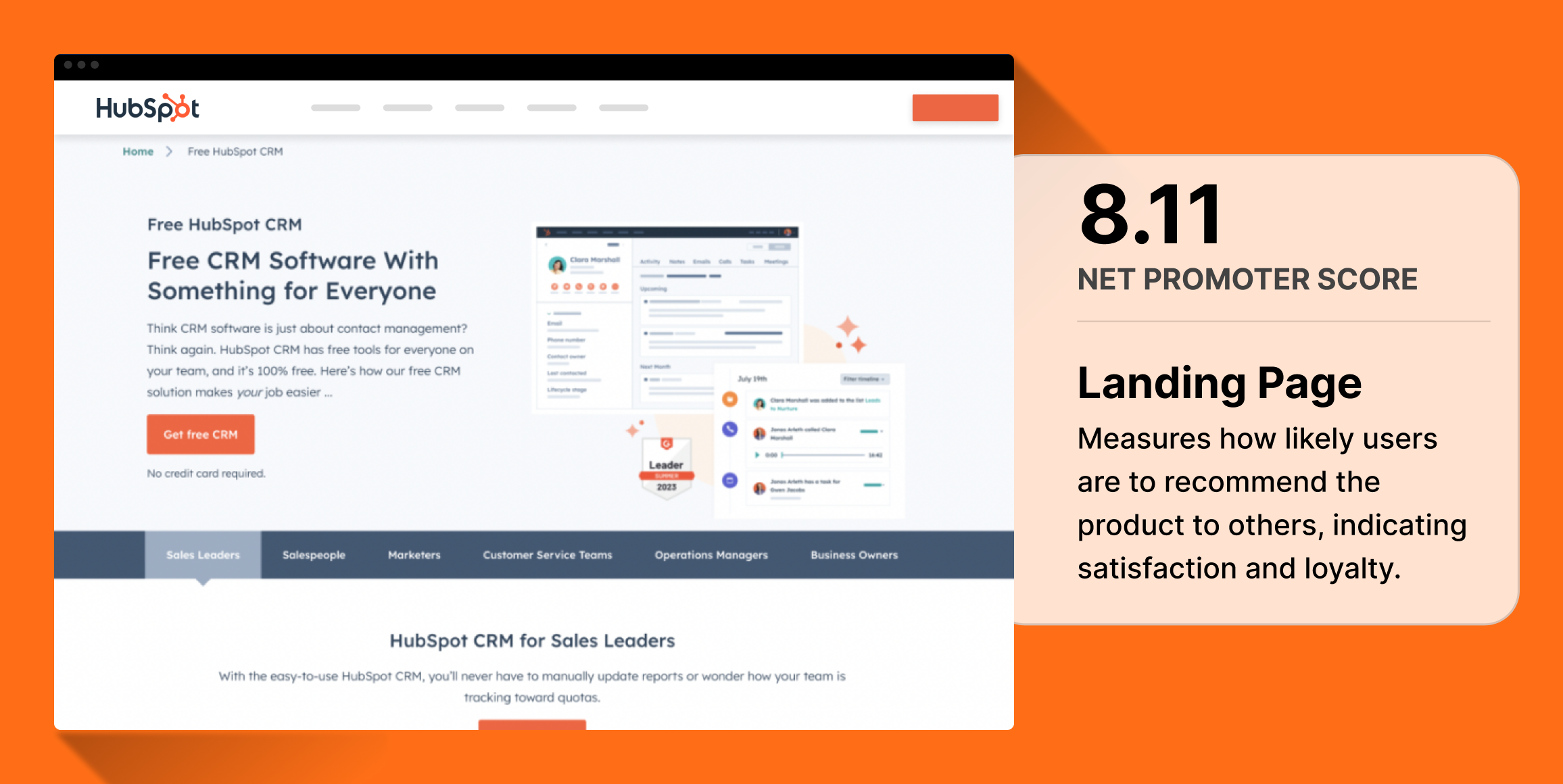Research Study
Hubspot Landing Page Optimization
Landing page test revealed successes of Hubspot’s site compared to competitors.


Average hero engagement
The ‘Get Free CRM’ CTA proved effective, with 31% of visitors clicking there first.
High positive sentiment
Increase of up to 20% in helpfulness compared to competitors.
Highest NPS among competitors
Hubspot produced the most net promoters compared to their key competitors.
Business Challenge
This independent research aimed to evaluate Hubspot’s CRM landing page to capture and convert visitors. The findings were compared with competitor landing pages to identify opportunities for optimization.

Timeline
The testing was completed in 24 hours. After running the test overnight, the findings were synthesized the following day.
Research Goals
The main goal of the study was to assess the clarity and appeal of the CRM offer presented on the landing page, and compare its performance to that of competitor landing pages.
Methodology
Hubspot’s landing page was tested using remote user surveys via Helio, incorporating quantitative and qualitative feedback from consumers. The same survey was applied to four competitor landing pages to benchmark Hubspot’s performance against competitors.
Participant Panel
The study gathered feedback from 100 marketing and sales professionals in the United States for each of the five landing pages tested.
Test Setup
The survey combined NPS scoring, satisfaction scales, and open-ended questions to gather quantitative and qualitative feedback on the effectiveness of the landing page.
The setup for the Hubspot landing page study included several key areas of focus:
- Comprehension: Participants were requested to explain the purpose of the page. This was done to assess whether the page’s messaging and design effectively conveyed its intentions and offerings. Frequent keywords in the responses, such as “CRM,” “software,” and “sales,” indicated that the page primarily promotes CRM software solutions for sales teams.
- First Interaction: Participants were instructed to click on the element they would typically select first while navigating online tools. The goal was to pinpoint the primary areas of interest or initial points of engagement on the page. A subsequent question inquired about the rationale for their choice, with frequent terms mentioned including “software,” “CRM,” and “free.”
- Information Seeking: Users were instructed to click where they would go to learn if the tool could be useful for their company. This helped to identify which parts of the page were perceived as most informative regarding product suitability. Reasons for their choices were explored in a follow-up question, with “product,” “company,” and “software” being frequent in the responses.
- Emotional Reaction: This question aimed to capture the overall impression the page gave to the respondents, allowing them to select from multiple options. They were also asked to explain their choices, providing insight into the user’s perception of the page’s content and design.
- Likelihood to Engage: A Net Promoter Score (NPS) question measured the likelihood that respondents would use Monday.com for their business or company, on a scale from 0 to 10. The median rating was an 8, with a follow-up question probing into the reasoning behind their rating. Keywords from the responses included “software,” “free,” and “business.”
The test was designed to assess how well the page attracted users’ attention, the clarity and usefulness of the information provided, the general impression of the page, and the likelihood of the product being adopted. The use of common keywords and follow-up questions offered deeper insights into user motivations and potential barriers to conversion.
Findings
Average hero engagement
- The ‘Get Free CRM’ CTA proved effective, with 31% of visitors clicking there first.

- This is the expected amount of engagement on a primary CTA for first clicks on a homepage, and is comparable to competitors such as Zendesk and Zoho.
High positive sentiment
- Increase of up to 20% in helpfulness compared to competitors.

- Hubspot’s landing page produced the most positive impressions out of the 5 competitors tested, tied with Zendesk at 160 Net Positive Alignment (the sum of positive impressions shared by visitors minus the sum of the negative).
Highest NPS among competitors
- Hubspot produced the most net promoters compared to their key competitors.

- Despite being tied for emotional reactions, Hubspot’s product was by far the most likely to be recommended to a peer or colleague based on a visit to the landing page.
Conclusion
Hubspot’s landing page proved to be one of the strongest among competitors, encouraging high engagement with their ‘free’ CTAs and producing the strongest net promoter score of the five CRM platforms.
Recommendations
- Double down on free offer – Building on this positive reception, HubSpot can further leverage its free CRM concept to strengthen user motivation and enhance its market positioning.
- Demo time – Hubspot leads the pack in conversions, thanks to its strategically placed demo CTA. Hubspot can take a note from Hubspot by providing demo opportunities on their landing page.
Reflections
Hubspot’s performance in the areas of emotional reception and net promoter score may have been promoted by its current brand awareness and dominant place in the CRM market.


